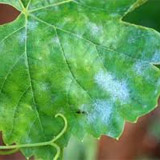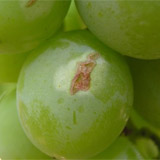Powdery mildew, also known as oidium, is caused by the fungus Erysiphe necator or (Uncinula necator). It is the most common and widespread disease of grapevines, with popular wine grape varieties varying in susceptibility to powdery mildew.
Powdery mildew symptoms can be seen on foliage, fruit, flower parts and vine canes. Powdery mildew usually appears as white powdery patches on the undersides of basal leaves. It may cause mottling or distortion of severely infected leaves, as well as leaf curling and withering. Lateral shoots are very susceptible, though grape berries are most susceptible to infection during the first three to four weeks after flavouring, infected berries may split and dry up or never ripen. Shoots, petioles and other cluster parts are susceptible all season, with old infections appearing as reddish brown areas on dormant canes.
Early powdery mildew infections can cause reduced berry size and reduced sugar content - so it is important to be aware of powdery mildew and its management as the resulting disease can significantly reduce crop yields. Most winemakers have a very low tolerance for powdery mildew on grapes, as some research has shown that infection levels as low as 3% can taint the wine and give off-flavours.
Once the ideal weather conditions occur - the white patches of powdery mildew produce millions of spores (conidia) which are spread by wind to cause more infections. Moisture is not the key concern - as the temperature is the most important environmental factor. The disease spreads quickly in early summer when temperatures are mild. The incubation time (the time between infection and the production of spores) can be as short as 5 to 6 days under optimal temperatures. Shaded and sheltered locations favour mildew development, as high temperatures and sunlight inhibit powdery mildew. Extended periods of hot weather above 32C will slow the reproductive rate of grape powdery mildew, as well as reduce spore germination and infection.










